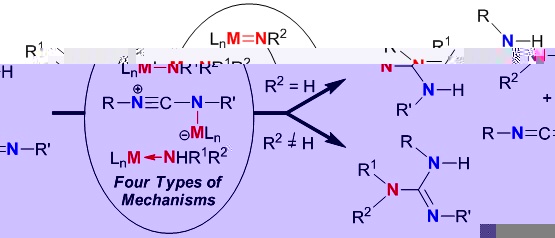研究室工作進展 Jun. 3rd, 2015
Mechanistic Considerations of the Catalytic Guanylation Reaction of Amines with Carbodiimides for Guanidine Synthesis
Ling Xu, Wen-Xiong Zhang,* and Zhenfeng Xi
Organometallics 2015, 34, 1787−1801 (Review).
Catalytic guanylation reaction of amines with carbodiimides has received the increasing attention because of the atom-economical preparation of guanidines since 2003. To date, more than forty catalysts including transition metals, main group and rare-earth metals have been designed and tested for the guanylation reaction to construct acyclic and cyclic guanidines. In this review, we present a mechanistic consideration on catalytic guanylation reaction of amines with carbodiimides for guanidine synthesis to elucidate its development and importance. Four different types of reaction mechanisms are well categorized: [2+2]-cycloaddition/protonation mechanism, insertion/protonation mechanism, activation of carbodiimide/nucleophilic addition/intramolecular protonation mechanism, and protonation/nucleophilic addition/disassociation mechanism. It is useful to understand this reaction processes and accelerate the rapid development in the related area to meet the needs of the growing guanidines.

亮點介紹
胍作為一類重要的含氮有機化合物,是許多生物活性物質的結構單元,同時也作為堿性催化劑在有機合成中有廣泛應用。胺對碳二亞胺的催化成胍(CGAC)反應,是一種直接的、原子經濟性的方法制備胍。因該反應的原子經濟性和胍的重要性,目前受到許多合成化學家和金屬有機化學家的廣泛關注。我們課題組在該領域做了系列的研究工作,例如: (1) 發現烷基鋁,Zn(OTf)2和稀土金屬催化劑等催化的高效合成胍的反應,并一鍋法高效構築了三氟甲基磺酸胍鹽;(2) 通過肼分子中N-N鍵的斷裂,實現了烷基锂催化的1,2-二芳基碳二亞胺的成胍反應構建胍;(3)無金屬催化劑的條件下三組分反應構建環狀胍。該系列成果發表在Organometallics 2009, 28, 882–887;Org. Biomol. Chem. 2010, 8, 1816–1820;Organometallics 2011, 30, 5278–5283;Org. Biomol. Chem. 2012, 10, 6266–6270(被OBC選為Cover Picture);Inorg. Chem. 2012, 51, 11941–11948;J. Org. Chem. 2014, 79, 12004–12009;Organometallics 2014, 33, 2784–2789;Org. Lett. 2014, 16, 6274–6277;Chem. Commun. 2015, 51, 254–265 ( Feature Article)。結合我們組和其他課題組的工作,從反應機理的角度詳細闡釋了該反應的發現,發展現狀與重要性。
